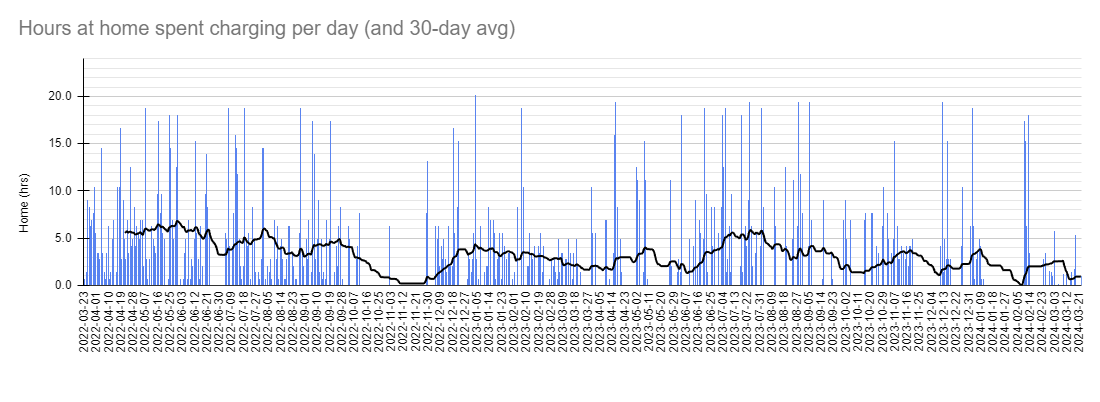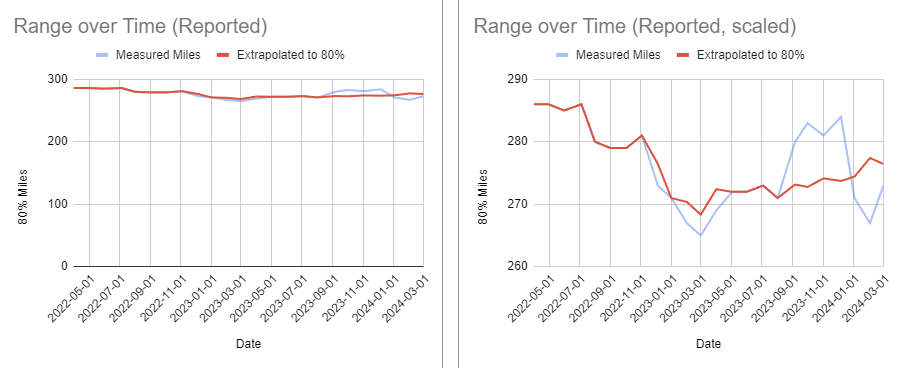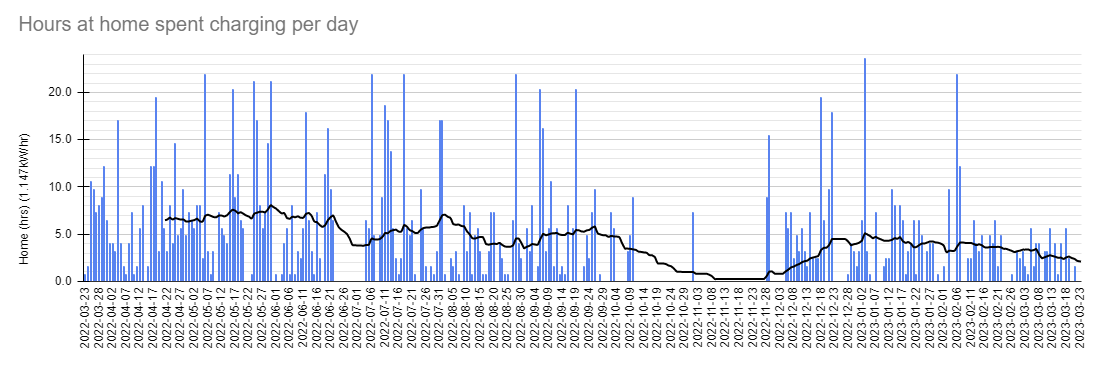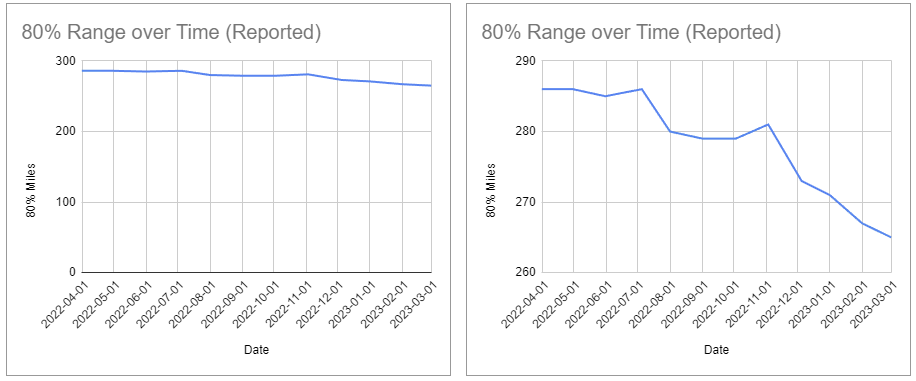
The charging graphs don’t look too different this year, I spent less time charging at home due to being on the road more:


Starting Range at 80% charge: 286mi Current Range at 80% charge: 278mi Estimated Lost Range: 8mi or 3%
This is actually better than at the Year 1 mark - I’m currently at 79% with an estimated 275mi of range, which extrapolated to 80% would put me at 278mi of range. This time last year, it was showing around 268mi of range at 80%. I attribute this to a change in charging style for the majority of Year 2, where rather than constantly plugging in at home and charging to 80%, I would only charge when the car got below 50% or so. This gives the car a chance to sleep for long enough that it opens the contactors and the BMS can get good readings on Open Circuit Voltage.

For all of Year 1 and for 11/12 months of Year 2, I only used L1 charging at home, and it was totally sufficient. In fact, it was sort of a point of pride - I owned an EV and didn’t have to do any special electrical work at home to make home charging work! And I could have continued that way, except while traveling a lot to my girlfriend’s parents’ house this winter, I found two things:
We weren’t staying at my girlfriend’s parents’ house since it was under construction, and I didn’t feel comfortable (or couldn’t access an outdoor outlet) with charging at the Airbnbs, so I’d charge when we went over to the construction site to work. Unfortunately, with the cold weather, that meant the car took extra long and so I had to spread out charging over a few days, and it was kind of a pain to leave it there overnight. On top of that, my car would be in the way of construction vehicles or deliveries, so I had to be around to move it. But then we discovered that they had a 14-50 outlet near their driveway (RV hookup?) and it made things so much easier that when we got home, I decided to upgrade my home charging too.
Due to my sub-panel size and the cost of copper wire, I decided to opt for a 14-30 rather than a 14-50. The 14-30 got me a 4x increase in charging speed, while the 14-50 would have gotten me a 6-7x upgrade. I decided that the 14-30 was a good balance of fast, cheap, and easy - and going to a 14-50 would have been both considerably more expensive and more work. Regrettably, I didn’t take advantage of PGE’s really good $500 charger rebate before they reduced it to $300, as that probably would have made the extra work worth it to go with a 60A breaker and wiring to install a dedicated L2 charger.
In any case, I’m happy with the speed of the 14-30. Since upgrading to it, I’ve averaged 1.6 hours per day of charging on the days that I do charge, and 36 minutes per day overall. And I should be able to charge 20-80% every night if I ever take on some crazy commute schedule.
This year was a lot more highway miles than last year, as I was making regular trips back and forth between Portland and my girlfriend’s parents’ house in Northern California (a little over 1000 miles roundtrip). That means more money spent at Superchargers, which is about 2.25x the rate per kWh as I pay at home. I would have expected to have worse efficiency due to highway speeds and cold weather driving, but at 297Wh/mi I’m doing better than last year’s 306Wh/mi. Maybe the difference is attributable to those early ownership hard accelerations.
Northern California in the winter means potentially driving in snow, or at least below freezing conditions, so I picked up some Nokian Hakkapeliitta R5EV snow tires and have been very happy with them. I’m planning to order another All Season Wheel and Tire package from Tesla to get another set of the 18” Aero wheels, though I’m not thrilled about the stock tires they come with (more below).
I mentioned a little before that cold weather charging is slower - I didn’t pay close attention to it, but I did notice that when I was plugged in at L1 and it was ~20’F, it took longer than I expected to charge up. It wasn’t impossible, I was still able to charge all I needed for the driving I was doing, but discovering I could charge at L2 at their house definitely made things more convenient. I would recommend any Tesla owner buy at least a 14-30 adapter for your mobile charger - I also have a 14-50 and TT30, and these are nice options to have for RV parks or Airbnbs when traveling.
The other thing worth talking about with cold weather is efficiency, but honestly, I didn’t pay much attention to it. I made the same drive through mountainous roads with snow, ice, and dry pavement probably 4 times and I didn’t notice a significant difference in arrival state of charge when I got to each Supercharger on the way. There probably was a few percentage difference, but I was never at risk of not making it to my next stop.
It’s really not that bad, DC fast chargers are needed for road trips, but if you’re just staying in a rural area, L1 will do fine a lot of the time, and there may be L2 chargers if you really need it (town halls, city parks, or RV parks). PlugShare is a good app to have to find these, but I didn’t need it at all during my time in rural Northern California. At most, you may need to plan a little more, and make sure you’re plugging in as much as possible if you have to drive 60 miles to a store on a regular basis.
Probably the biggest annoyance I had to deal with this last year was the foam detaching from the inside of the stock Michelin Primacy MXM4 tires. This caused a vibration from 55-70mph, and despite taking it to 2 shops, 4 different times, no one was able to identify and fix the issue until I had researched it and suggested they look for this specifically. This cost about $300 to have a shop remove, which did fix the vibration, but then I also replaced the tires entirely about a month later when I switched to snow tires. The Michelins were worn enough that they weren’t worth keeping, but in retrospect, I probably should have just gotten the snow tires sooner and saved myself the $300.
I had a few more Service Center visits - two TPMS sensors stopped responding (battery probably) and needed to be replaced under warranty, and my car was broken into in Oakland, CA when we were visiting, and I had to get the rear quarter window replaced, fortunately covered by insurance.
I’m not sure there have been a ton of significant upgrades through Over The Air updates this year - they added a blind spot “highlight” to the blinker cameras, which is a nice addition, but nothing else feels as significant as the ability to reposition those blinker cameras on the screen. Well, I guess they did introduce 1-pull to enable AutoPilot (which means you can’t enable just Traffic Aware Cruise Control anymore, if you turn on this function). I do feel this is a nice change, and I haven’t found myself wanting TACC-only since switching it on, but it’s also pretty minor.
Surprisingly, I have been following the Full Self Driving Beta version 12 results and I’m kind of tempted to try it out (via the monthly subscription) once it goes wide-release. It’s looking pretty promising and has corrected a lot of the issues in version 11, though it’s still definitely not where I had thought it was prior to buying the car.
I don’t have as much to say after year 2 compared to year 1, but I am still very happy with the car, and with owning an EV. I hope the DC fast charger infrastructure continues to improve, and non-Tesla EV owners get to start enjoying the convenience of the Tesla Supercharger network. I’m still a long way from considering replacing the Model 3 with something else, but I will say the Rivian R2 looks pretty tempting…
I’ve tracked this closely to decide whether or not it would be worth it to upgrade to a Level 2 charger at home - my initial assumption is I’d have to do this, but after a year, the data shows that this is completely unnecessary given my usage. For how little I drive day-to-day, my Level 1 home charger (which came with the car at the time) is more than sufficient.
Upgrading to a Level 2 charger would cost, at minimum, $200 (with utility EVSE discount), assuming I do all the work myself, and can reuse the A/C circuit from the garage subpanel, which would be less-than-ideal. More realistically, it would probably be closer to ~$1000 for a dedicated circuit, possibly ran from the main panel. However, there’s just not sufficient benefit to justify that - I can think of one, maybe two times in the last year that I would have benefited from the L2 charger: once when we were doing a lot of driving one weekend, and once when my family was visiting and also rented a Model 3. In both of those cases, a $10-$20 DC faster charger stop would have helped with the anxiety, but neither ended up being an actual problem.
Overall average miles driven (with roadtrips): 29.54 per day

I haven’t tracked the time here as closely, so this is more anecdotal. The vast majority of my charging on the road (due to road trips), has been on the Tesla Supercharger network, but I’ve had a handful of L2 charging at RV sites and hotels (with 14-50 or TT30 adapters), and purchased the CCS1 adapter for use at non-Supercharger DC fast charging stations, and have used those a handful of times as well.
To make a broad statement: I don’t spend a lot of time waiting around for the charging to finish.
Early on, I think I tended to charge the way one would fill-up a gas tank: run it low, then charge back up to full. The generally accepted wisdom these days is to make “frequent short stops” not “infrequent long stops”. I.e. charge 4x at 15 mins each, rather than 2x at 40 mins each (charge rate is nonlinear, so it takes longer to go 80->90% than it does to go 50->60%).
Supercharging has consumed the majority of cost, but isn’t the majority of charging, it’s just expensive.

I normally set my maximum charge to 80%, as that supposedly extends the life of the battery. Since getting the car, I’ve recorded the estimated range when charged to 80% each 1st-of-the-month. About 6 months in, it began stopping at 79% charge, though I suspect this is a display issue (it can certainly charge above 80% if I set it to do so, and I suspect if I set the max to 81%, it would stop at 80%).
The purpose of this is to try to estimate how much range (or total capacity) has been lost since getting the vehicle:

Spurious reports from the internet suggest the range loss curve is steeper at the beginning of ownership, and levels out over time.
This post on Tesla Motors Club also suggests some of the loss may be due to the Battery Management System (BMS) being unable to correctly estimate range because of charge conditions - which is plausible with how I use the car: it may not be getting many opportunities to take Open Circuit Voltage (OCV) readings at various states of charge (SOCs) in order to calibrate the range estimate. Going forward in year 2 of ownership, I’m planning to not leave the car plugged in at home as much, so it’ll get to take OCV ratings at more various SOCs.
That all said: I’m not worried! I haven’t been stranded yet, or even come close, and the ~335 miles or range I’m estimated to have at 100% SOC is more than enough to get me between chargers (DCFC, L2, or even L1 if I’m patient).
An EV (or at least, a plug-in hybrid) was on my list of things to buy for several years. Probably at least 2, possibly 3 years. During that time, I made several lists, watched lots of videos, did lots of comparisons, and narrowed my picks to 3 cars, in chronological order:
The V60 remained at the top for a long time, and if it had the Polestar 2 drivetrain, it probably would have won out (I just don’t love the looks of the Polestar 2, the V60 wagon is way cooler). But I wanted a full EV, not just a plug-in hybrid.
When the EV6 was announced, I put in a pre-order for it, and was eagerly awaiting it. Unfortunately, Kia really botched the lead-up to their US rollout. The specs kept changing constantly on the website, and it wasn’t clear until much later what range, horsepower, or features would be coming to the US, so eventually I canceled my pre-order and ordered a Tesla Model 3.
But before pulling the trigger, I listed out some priorities and assigned scores to the Model 3 and the EV6, to see if that was the right choice.
Have the Priorities I defined held true? I.e. have the things that were priorities for the Tesla actually been used as much as they were estimated to?
There were two things that I didn’t put on the comparison list when I was making my decision, but they were in the back of my mind:
If I could go back to a year ago and do it all again, I think the only place where I’d have pause is if a Ford F-150 Lightning were available for comparable price. Unfortunately, back then (and still to this day?), that’s not the case: the Lightning is super hard to come by and they want like $80K+ for comparable range. Granted, it has features the Model 3 doesn’t: a bed, towing capacity, V2H, and ground clearance, but I’m not sure those are worth $25k+. If I was considering home battery backup, the V2H cost savings, even with bidirectional charging infrastructure, would be worth it, but that’s not a priority at the moment.
I think the next place I’ll be looking for an EV is a Ford eTransit or equivalent, if they can provide range over the current 108 miles. We have ambitions for a van conversion, but 108 miles really isn’t enough to make that a reality on an EV platform. We both kind of feel that if we’re going to spend that much money on something, we’d like it to be an EV, it just seems like the way of the future. Hopefully in the next year or two the range will get high enough to be acceptable.